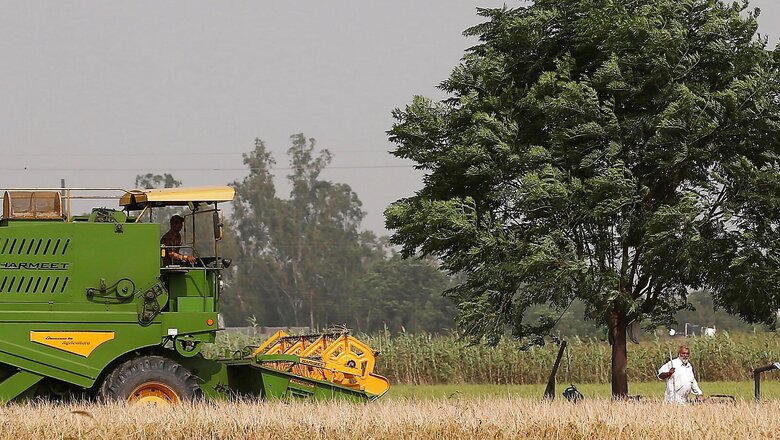
views
Punjab and Haryana’s farmers’ obsession with unsustainable big cereals wheat and paddy has begun to hurt, as returns diminish. The climate crisis farmers faced this time was the hottest months of March and April in the past 122 years. The northern and central parts of the country reel under heat waves, that is, temperatures around 45 degrees Celsius and even more. A climate crisis as high rise temperatures has reduced the yield of the harvested crop up to 25 per cent. Temperature rise has shrivelled up wheat grain and other Rabi crops resulting in low yield and raising worries among farmers about just-sown pulse crops.
According to a report tabled in parliament by the parliamentary standing committee on agriculture in August 2017, “the climate change is expected to reduce rice production by 6 to 8 per cent by 2022.” One degree Celsius rise in minimum or maximum temperatures during cropping season could decrease the yield by 8 to 10 per cent.
Agro-scientists reveal that the “average rise in temperature during the past 100 years was 0.75-degree Celsius, which would be 1.5 to 4.5 degrees Celsius in the next 100 years, which would adversely affect the crop pattern and threat to human life and ecosystem”.
Without support from farmers, agriculture has also become one of the major factors in the climate crisis. It currently generates 19–29 per cent of total greenhouse gas (GHG) emissions. Due to a lack of awareness and adaptation of sustainable alternatives, that percentage could rise substantially as other sectors reduce their emissions. Additionally, one-third of food produced globally is either lost or wasted. Addressing food loss and waste is critical to helping meet climate goals and reduce stress on natural resources.
Also Read: Unlocking Jobs is Punjab’s Big Challenge, AAP Govt Must Get Ease of Logistics on Track
Natural resources, including soils, water, and biodiversity, are stretched dangerously thin while Haryana and Punjab propelled India’s Green Revolution five decades ago, rescuing millions from hunger but the gains are fast eroding.
The sustainable solution of Climate-Smart Agriculture (CSA), incorporates three specific goals: first, is sustainably increasing productivity and a decent income, second increasing innovation adaptation, and third, reducing greenhouse gas emissions.
Overuse of water, fertilizers and pesticides
After the implementation of the Food Security Act, the country is once again looking toward Punjab, but Punjab farmers need to conserve its soil and water management along with adopting diversification in agriculture and venture into agro-processing to reach out to the global market. It is the need of the hour for sustainable agricultural development and a safe environment.
Indian farmers take about 5400 litres of water to grow one kg of rice, five times the amount China uses, pointing to the state’s low water productivity and that’s why 131 of the 148 blocks in Punjab are overexploited. Paddy takes up a groundwater extraction rate of 165 per cent, a jump of 16 percentage points in the last eight years. About 14 lakh shallow tube wells dig deeper and deeper every year. Northern and central districts of Punjab are severely water depleted, while south-western districts face waterlogging and soil salinity or alkalinity. Muktsar, Fazilka, Bathinda and Faridkot of the Malwa region are notoriously degraded. The Central Ground Water Board put out a dire warning- ‘at the current rate of water extraction, Punjab would be a desert within the next quarter-century.’
Indian farmers take about 5400 litres of water to grow one kg of rice, five times as much China uses, pointing to the state’s low water productivity and that’s why 131 of the 148 blocks in Punjab are overexploited.
In irrigated areas, a typical farmer now uses 3.5 times more fertilisers and pesticides than in 1970 to get the same output. Although Punjab has only 1.5 per cent of the land area of India, it uses about 19 per cent of the total pesticides used in the country. Moreover, the south-western districts of the Malwa region are consuming about 75 per cent of pesticides used in Punjab state. There are serious environmental problems and health concerns resulting from the use of pesticides. Studies have shown that there are pesticide residues in milk, fruits and vegetables.
Ironically, as much as 78 per cent of pesticides and fertilisers are lost to the environment, causing soil, air and water pollution. In addition, the soils of Punjab have become deficient in micronutrients. Consequently, input-intensive agriculture has made us calorie-secure, According to the National Family Health Survey (NFHS)-4, “ 57 per cent of women and 36 per cent of children under the age of five in the Malwa region are stunted and anaemic.”
Centre and State Support Missing
Farmers need a decent income to solve their multidimensional crisis. Sustainable agriculture may hold the key. The Council on Energy, Environment and Water (CEEW) identified 16 sustainable agriculture practices (SAPs), such as organic farming, integrated farming systems, agro-forestry and precision farming. These could be economically remunerative, socially inclusive and environmentally benign. A few states are already at the vanguard of this revolution. Sikkim is a 100 per cent organic state, and Andhra Pradesh aims at 100 per cent natural farming by 2027.
Yet, sustainable agriculture remains at the margins and no single practice has been adopted by more than 4 per cent of farmers. Support from the Centre is limited. India’s National Mission on Sustainable Agriculture receives only 0.8% of the agricultural budget of Rs 1.42 trillion. Punjab has never been able to implement an agenda of crop diversification. The lack of state support limits the mainstreaming of sustainable agriculture.
The Way Forward
Higher ambient temperatures and less predictable rains may only worsen in the years ahead, increasing the vulnerability of farmers. Could embracing sustainable agriculture improve farm incomes and nutrition security in a world where the climate is changing? How can we scale it up?
Climate-smart agriculture (CSA) is an integrated approach to managing landscapes—cropland, livestock, forests and fisheries—that addresses the interlinked challenges of food security and accelerating climate change. Integrated agriculture practices that could enable higher crop diversity from staples to high-value crops, fruit and vegetables, dairy, poultry, fisheries, beekeeping and mushroom cultivation can give additional nutritious food without affecting the production of grains.
Instead of input-based subsidies for fertiliser and power, India must incentivise outcomes such as annual nutrition output per hectare and enhanced ecosystem such as water conserved or desertification reversed. Outcome-based support could encourage innovation among farmers and allow the adoption of alternative approaches. The rigour of regular comparisons of outcomes amid the climate crisis is important for safeguarding farm decent income, nutrition security and natural resources.
The author is former Vice Chairman of the Punjab Planning Board and Chairman of ASSOCHAM Northern Region Development Council. The views expressed in this article are those of the author and do not represent the stand of this publication.
Read all the Latest Opinions here



















Comments
0 comment